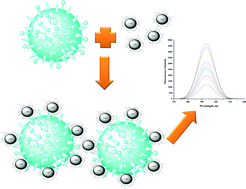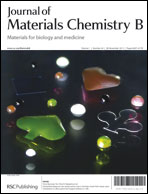Probing the interactions of chitosan capped CdS quantum dots with pathogenic bacteria and their biosensing application†
Abstract
Chitosan modified CdS quantum dots (CdS@CTS) can be used as an effective bacterial biosensor due to their good bioaffinity among chitosan molecules and bacterial membranes. CdS@CTS is an ultrafast, sensitive, direct and biocompatible biosensor for pathogenic bacteria (Pseudomonas aeruginosa and Staphylococcus aureus). Chitosan biopolymer of CdS@CTS provides bioaffinity sites that can be employed for the assembly on pathogen bacteria cells due to the chemical similarity of the chitosan and the bacteria membranes. Thus, S. aureus and P. aeruginosa cells were detected at low concentrations of 150 and 200 cfu mL−1, respectively, in an extremely short time (1 min). The CdS@CTS–bacteria interaction is noncovalent. From the thermodynamic results, the van der Waals force and hydrogen bonding formation are characterized by negative enthalpy (ΔH), while positive entropy (ΔS) is considered as the evidence for typical hydrophobic interactions. Moreover, negative ΔH and positive ΔS might play a role in the electrostatic interactions. The negative free energy (ΔG) shows that the binding events were spontaneous processes. Matrix assisted laser desorption/ionization mass spectrometry (MALDI-MS) and transmission electron microscopy (TEM) were performed to evaluate the interactions and the biocompatibility of CdS@CTS toward bacteria cells. Their biocompatibility, together with the high sensitivity and the presence of multifunctional forces, making these quantum dots (CdS@CTS) an excellent and novel biosensor which can be widely applied in the near future.


 Please wait while we load your content...
Please wait while we load your content...